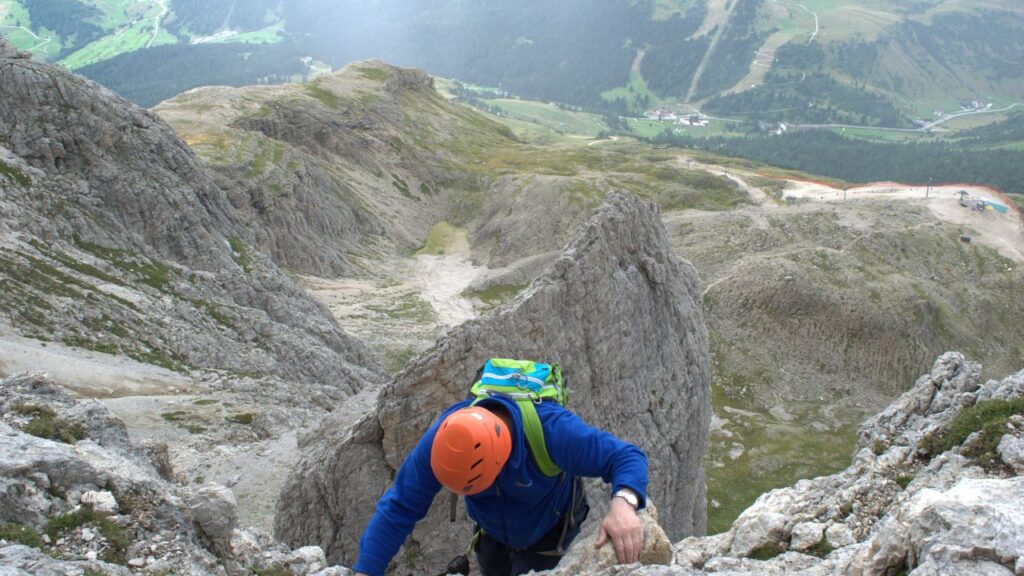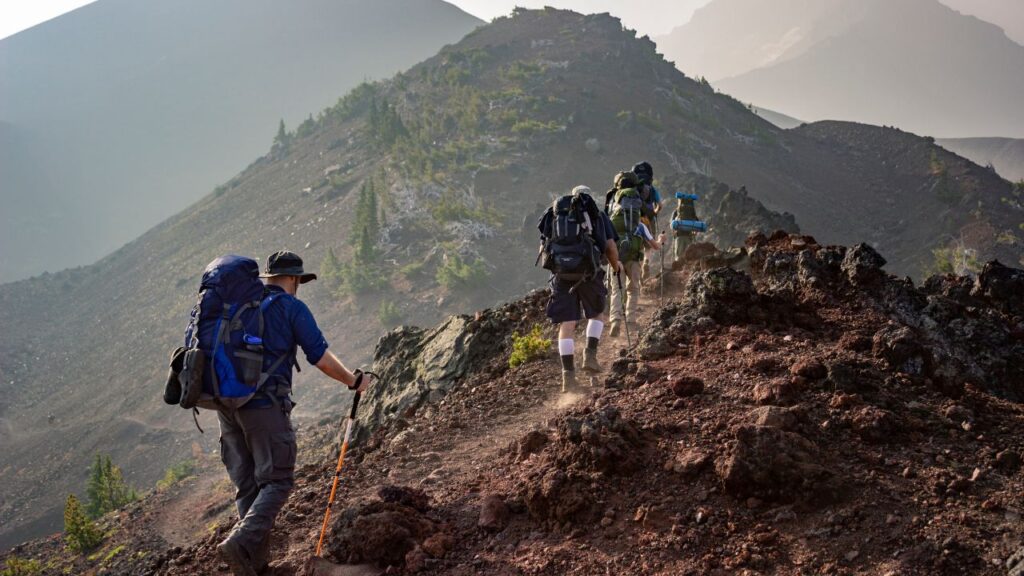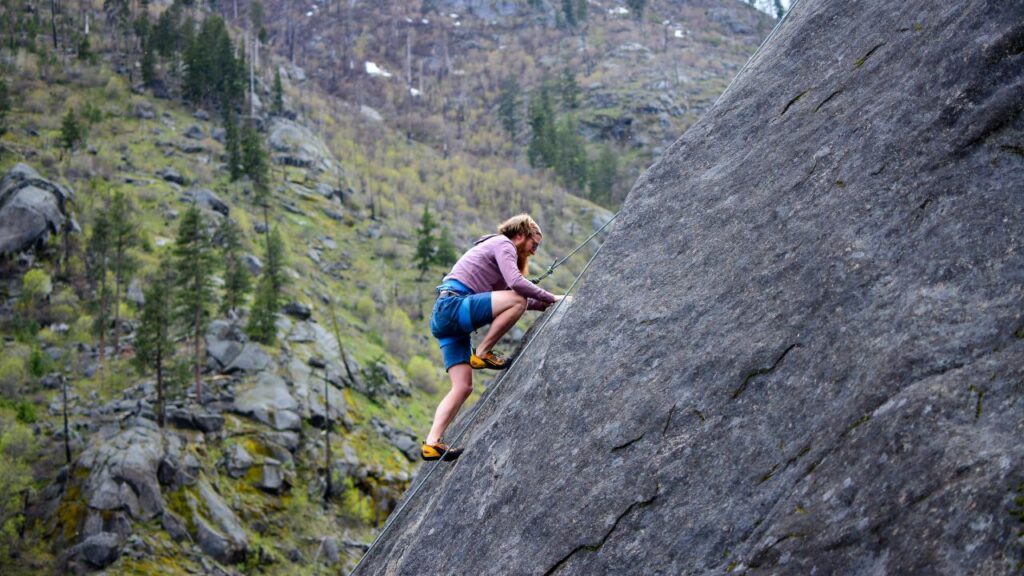Rock climbing is far more than just an adventurous outdoor pursuit; it is a physically demanding and exhilarating sport that engages the entire body. For fitness enthusiasts seeking to build muscle and strength while enjoying the thrill of conquering new heights, rock climbing presents a unique and effective opportunity. The question “Can rock climbing build muscle?” has piqued the curiosity of many fitness enthusiasts and aspiring climbers alike.
In this article, we will explore the specific muscles involved, the benefits it offers, and the strategies to maximize muscle development through this dynamic and challenging sport. Whether you are an experienced climber looking to take your strength to new heights or a curious beginner contemplating the transformative effects of rock climbing, this comprehensive exploration will shed light on the remarkable potential of this sport in building muscle and achieving your fitness goals.
Table of Contents
What Muscles Are Used in Climbing?
 Rock climbing requires a symphony of muscles working together to propel climbers upwards. These muscles can be broadly categorized into three groups: upper body, middle body or core, and lower body. Understanding these muscle groups will provide insight into how rock climbing helps build strength.
Rock climbing requires a symphony of muscles working together to propel climbers upwards. These muscles can be broadly categorized into three groups: upper body, middle body or core, and lower body. Understanding these muscle groups will provide insight into how rock climbing helps build strength.
Upper Body
- Deltoids: The deltoid muscles, located in the shoulders, play a pivotal role in rock climbing. They facilitate pulling movements and assist in stabilizing the arms during challenging ascents. Strong deltoids contribute to enhanced shoulder stability, crucial for maintaining control on the climbing wall.
- Biceps: Crucial for bending the elbows, the biceps are essential for gripping holds and executing pulling movements during climbing. As climbers hoist themselves upward, these muscles bear a significant load, making them crucial for successful ascents.
- Triceps: Located on the back of the upper arm, the triceps muscles are responsible for extending the elbow. They assist in pushing movements during climbing, helping climbers gain upward momentum and execute powerful moves.
- Forearms: The forearm muscles are a focal point of strength during rock climbing. They are heavily engaged in gripping and holding on to the rock surface, providing the necessary support to secure each hold and progress through the route.
- Pecs (Pectoralis Major/Minor): While not the primary muscle group engaged in climbing, the pectoral muscles contribute to stabilization during certain maneuvers. They assist in maintaining balance and control, particularly in overhanging or dynamic climbing situations.
Core
- Lats (Latissimus Dorsi): The latissimus dorsi, commonly known as the lats, are broad muscles in the back that have a significant impact on climbing. These muscles are crucial for powerful pulling movements, allowing climbers to generate force and efficiently navigate challenging routes.
- Abdomen: The core muscles are central to a climber’s stability and performance. Engaging the abdominal muscles helps maintain body tension, enabling climbers to control their movements and position on the wall.
Proper engagement of the core muscles is vital for effective weight distribution, balance, and precise footwork during climbs.
Lower Body
- Glutes: Located in the buttocks, the gluteal muscles play a key role in pushing movements during climbing. They provide the necessary power to push off footholds and execute dynamic movements, contributing to a climber’s upward progress.
- Thighs: Climbers rely heavily on their thigh muscles for powerful leg movements and stability. Strong thighs aid in maintaining body posture and control, allowing climbers to execute precise foot placements on the wall.
- Calves: The calf muscles assist in pointing the toes and pushing off footholds, contributing to a climber’s overall agility and footwork precision.
Does Rock Climbing Actually Build Muscle Mass: Yes Or No?
 The question of whether climbing can lead to muscle growth is often raised by fitness enthusiasts. The answer, however, is a resounding “Yes!” Climbing is, indeed, an effective way to build muscle mass. It engages multiple muscle groups throughout the body and applies resistance against body weight, similar to weight training.
The question of whether climbing can lead to muscle growth is often raised by fitness enthusiasts. The answer, however, is a resounding “Yes!” Climbing is, indeed, an effective way to build muscle mass. It engages multiple muscle groups throughout the body and applies resistance against body weight, similar to weight training.
However, the extent of muscle mass gain through climbing varies from person to person due to individual factors. The amount of muscle you can build will depend on various elements, including your training regimen, diet, and genetic makeup.
To maximize muscle growth through climbing, consider incorporating the following tips into your routine:
- Progressive Training: Gradually increase the difficulty and intensity of your climbing sessions to challenge your muscles continuously.
- Balanced Diet: Ensure you consume adequate protein to support muscle repair and growth.
- Rest and Recovery: Allow your muscles ample time to recover between climbing sessions to avoid overtraining and reduce the risk of injury.
- Supplemental Exercises: Include specific exercises targeting the muscles used in climbing to complement your training.
How to benefit from climbing without worrying about muscle imbalances?
 Rock climbing is not only an adventure sport but also an exceptional full-body workout that engages various muscle groups simultaneously. To harness the maximum benefits of climbing while avoiding muscle imbalances, it’s crucial to adopt a balanced approach to training. This involves targeting different muscle groups, incorporating rest and recovery, and focusing on overall fitness. Let’s explore the key elements of maintaining a balanced training routine and the advantages of climbing without worrying about muscle imbalances.
Rock climbing is not only an adventure sport but also an exceptional full-body workout that engages various muscle groups simultaneously. To harness the maximum benefits of climbing while avoiding muscle imbalances, it’s crucial to adopt a balanced approach to training. This involves targeting different muscle groups, incorporating rest and recovery, and focusing on overall fitness. Let’s explore the key elements of maintaining a balanced training routine and the advantages of climbing without worrying about muscle imbalances.
Balanced Muscle Engagement in Climbing
Climbing requires the harmonious involvement of both upper body and lower body muscles, as well as core strength. The muscles used in climbing, as mentioned earlier, include the deltoids, biceps, triceps, forearms, pectorals, glutes, thighs, calves, lats, and abdomen. Each muscle group plays a specific role in propelling climbers upward and maintaining stability on the wall. By actively engaging these muscle groups, climbers not only build strength but also improve coordination and body control.
Training Strategies to Prevent Muscle Imbalances
1. Symmetrical Training:
Symmetrical training involves working both sides of the body equally during climbing exercises. This strategy ensures that one side doesn’t become significantly stronger than the other, preventing muscle imbalances. For example, if you perform a certain number of pull-ups with one arm, repeat the same with the other arm. By maintaining symmetrical strength, climbers improve overall balance and coordination, reducing the risk of overuse injuries caused by muscle imbalances.
2. Cross-Training:
Cross-training is the practice of engaging in activities that complement climbing and target different muscle groups. Activities like yoga, Pilates, or resistance training can help strengthen muscles that may not be heavily engaged during climbing. By diversifying workouts, cross-training enhances overall fitness and reduces the likelihood of specific muscle groups becoming overdeveloped or underdeveloped.
3. Varied Climbing Routes:
Switching up the types of climbing routes and techniques practiced engages various muscle groups, promoting a balanced workout. Different climbing routes challenge climbers in unique ways, targeting muscles from different angles and intensities. By varying climbing routes regularly, climbers can avoid over-relying on specific muscle groups, leading to more balanced muscle development.
4. Strength Training:
Incorporate strength training exercises that complement climbing movements and improve overall body strength. Focus on exercises that engage multiple muscle groups, such as functional movements like squats, lunges, and deadlifts. Building overall strength contributes to improved climbing performance and a reduced risk of muscle imbalances.
Final Thoughts
Rock climbing stands as a challenging yet rewarding sport that offers numerous benefits, including the ability to build muscle mass and improve overall fitness. By engaging various muscle groups throughout the body, climbing provides a full-body workout that helps enhance strength and endurance. However, it’s essential to maintain a balanced training regimen and consider rest and recovery to prevent muscle imbalances. So, whether you’re an experienced climber or a beginner looking to embark on this thrilling journey, rock climbing can undoubtedly be a valuable addition to your fitness routine.
Related Questions
1. Can Rock Climbing Improve Muscles Level?
Rock climbing is an exceptional activity for improving muscle strength and endurance. It engages various muscle groups, such as the arms, back, core, and legs, providing a full-body workout that can lead to significant muscle development.
2. Is Rock Climbing Effective for Sculpting Abs?
Yes, rock climbing can be highly effective for sculpting abs. The sport requires core engagement to maintain stability and balance while climbing. Constantly engaging the core during climbs helps strengthen and define abdominal muscles over time.
3. Will Rock Climbing Aid in Weight Loss?
Rock climbing is a physically demanding activity that burns calories and promotes cardiovascular health. When combined with a balanced diet, it can contribute to weight loss and improved overall fitness.
4. What Additional Exercises Support Muscle Building for Climbing?
To complement rock climbing, incorporate exercises that target specific muscle groups not heavily engaged during climbing. Strength training exercises like pull-ups, push-ups, lunges, and deadlifts can further enhance muscle development.
5. How Often Should I Rock Climb to Achieve a Lean and Muscular Physique?
The frequency of rock climbing sessions depends on individual fitness goals and recovery capacity. To achieve a lean and muscular physique, consider climbing at least 2-3 times a week, with rest days in between for muscle recovery.
6. Which Muscles Play a Key Role in Rock Climbing?
Rock climbing engages multiple muscle groups, but some key muscles include the forearms, upper back (including lats), shoulders, core, and leg muscles. These muscles are crucial for supporting body weight and executing climbing movements.
7. What Rock Climbing Techniques Enhance Muscle Development?
Techniques like campus boarding, fingerboard training, and dynamic moves can specifically target and strengthen muscles used in rock climbing, promoting muscle development and overall climbing performance.
8. Can Rock Climbing Replace Traditional Gym Workouts?
While rock climbing offers a comprehensive full-body workout, it may not target all muscle groups equally. Combining climbing with traditional gym exercises can provide a more well-rounded approach to overall fitness.
9. Is Weight Training a Beneficial Addition to Rock Climbing?
Supplementing rock climbing with weight training can be advantageous for building overall strength and addressing muscle imbalances. Targeted weight training exercises can enhance climbing performance and reduce the risk of injury.









Discussion about this post